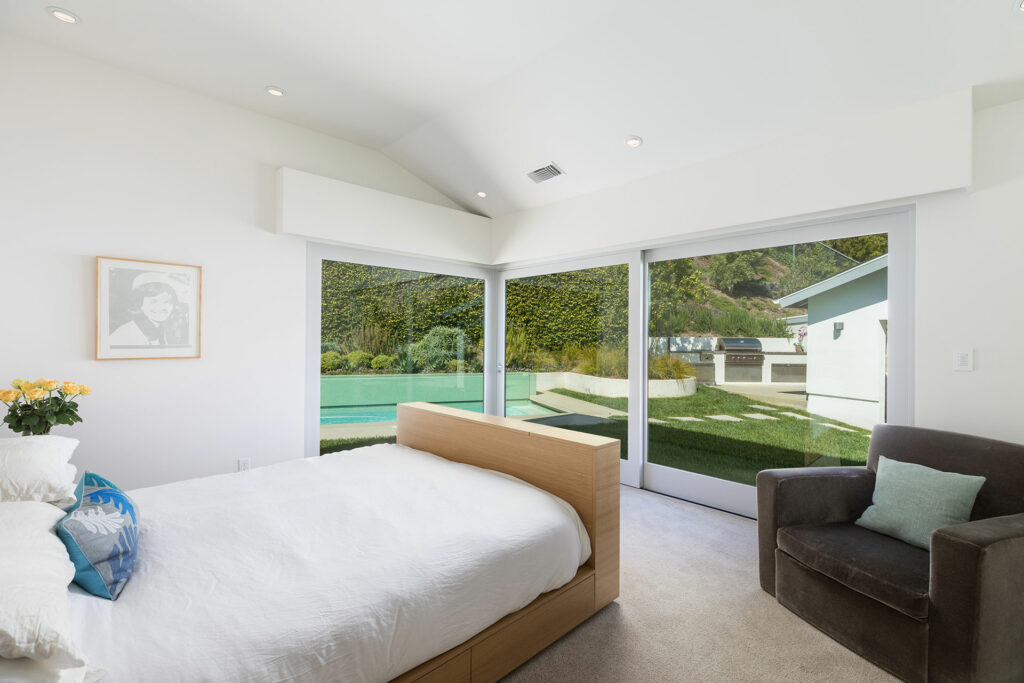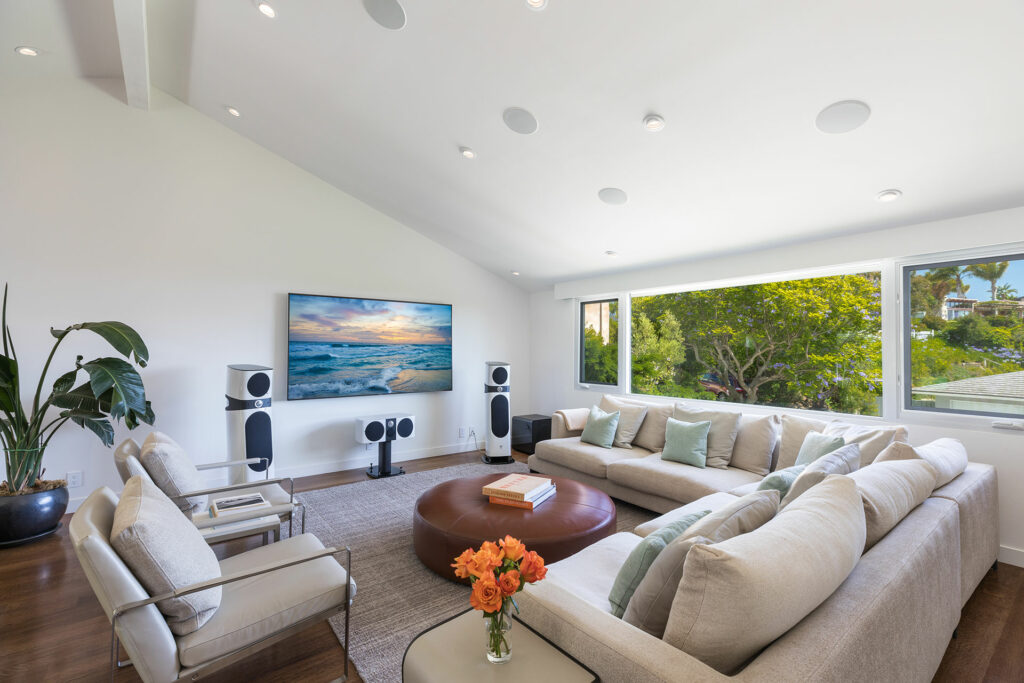Audiophiles have a long and strange relationship with video, be it TVs or projection. Many old-school audiophiles refuse to put a television between their best audiophile loudspeakers when home theater enthusiasts use this configuration as the basis for their entire AV system. Dating back to the days of gigantic CRT sets as well as even bigger big-screen TVs, you can see how your center image might suffer with that much physical mass parked between your expensive and well-loved loudspeakers. Today, though, things are much different in terms of the form factor of the best video displays. And yet, some people argue that a big chunk of glass behind and in-between your speakers can cause reflections in ways that, say, a painting or an acoustical treatment doesn’t. With that said, it is really hard to watch Billions on an RPG diffuser, isn’t it?

Television, as a medium, is simply the best art form out there right now. Hollywood movies are less-than-excellent these days, while today’s television shows are simply excellent – especially the ones delivered via any number of streaming sources, from Netflix and Apple to Hulu and Max or any number from a growing list of streaming options. Believe it or not, the quality of the audio in said shows is excellent, and with an under-$100 streamer or end-point (think: Apple TV, Roku, etc.) you not only get television sound that is well recorded, but you have it paired with wonderfully colorful and amazingly resolute 4K (now sometimes even 8K) video. That is especially true for binge-worthy shows, a nearly unlimited amount of sports and even documentaries like Somebody Feed Phil (on Netflix) or other escapist food porn shows like Chef’s Table.
Much like exploring new music, television is offering up so much good content today that it is a crying shame not to have audio playback that matches the gorgeous imagery. If an audiophile was worried about sonic reflections, how about having an acoustically absorbent cover made for your TV that can absorb sound when the TV is not in use but also be easily removed when it is time for a few episodes of The White Lotus or the final round of The U.S. Open? A seamstress or possibly even the tailor at your local dry cleaner could likely make you a sonically absorbent cover for the hard surfaces on the TV that you might pair with your audiophile system. This can be done for less than the cost of a modest audiophile interconnect.

Today’s TVs are amazingly easy to install and even hide. Modern television sets are very, very thin and can be mounted right up next to the wall. Today’s TVs can also go on a lift and he hidden inside furniture or other locations while not in use. I did this a few years back at my last house by having a custom bed made that hid a small TV on an Auton lift. All-in, hiding my bedroom television might have cost me $1,500 to not have a TV stuck on a wall. Samsung’s Frame products (I have two of them now: a 55 inch and a 65 inch) bring the concept of your television being a like a framed piece of art on your call. The cables and electronics are hidden either in the wall or behind the TV. There’s no space around the set, which flush-mounts to the wall for a very clean look. The Samsung Frame comes on different colors for the frame and connects to your photos or Samsung’s own art collection so that you have an ever-changing art gallery between your speakers.

Another option is to use a projector and a screen. Projection screens aren’t as reflective as a flat television; however, even small video projectors tend to make a bit of noise because of the fan cooling the bulb. If you can get past the fan noise issue, a projector could be a good solution as you get a much larger screen for your money, but I think adding a projector to a dedicated audiophile system would have more potential downsides than upsides. Also, with projectors there is a certain barrier to entry for firing up your projector versus just turning on a TV. I am not why that is, but I’ve had multiple systems with both a projector and screen rig as well as a nice, big, flat UHD television. I prefer the form factor and brightness of the television over size advantages of a two-piece system.
There are all sorts of hang-ups and oddities in the audiophile hobby that don’t always make sense to mainstream consumers and/or newly christened audiophiles. Does a bigger, heavier amp always sound better? How is bass somehow better from a big pair of speakers versus a smaller pair of speakers with a well-tuned subwoofer? Some of these biases need to go away going forward so that the audiophile hobby is more accessible to more and more music-loving, tech-savvy men and women from younger generations. Embracing the creative power and window-on-the-world type of access that today’s remarkable UHD televisions can deliver is yet another issue that we could us to stash in our audiophile past.
The Etymology of the Word Audiophile and Videophile
The words audiophile and videophile are modern linguistic inventions, combining classical roots with post-war consumer technology culture. While today these terms are commonly used to describe enthusiasts of high-fidelity sound and picture quality, their origins are fairly recent—grounded in Greek etymology but shaped by the rise of consumer electronics in the 20th century.
Let’s start with the root. The suffix “-phile” comes from the Greek philos, meaning “loving” or “fond of.” It’s used across a range of English words—bibliophile (book lover), cinephile (film lover), Anglophile (one who loves English culture), and so on. It’s a way of categorizing passion or deep interest in a subject, typically with a scholarly or obsessive edge. So, a “phile” is never just someone who likes something casually. It implies dedication, discernment, and even identity.
The prefix “audio-” stems from the Latin audire, meaning “to hear.” Combined, audiophile literally means “lover of sound.” While the components of the word are ancient, the term itself didn’t come into common use until the 1950s, when high-fidelity home audio began emerging as a cultural phenomenon. The rise of LP records, vacuum tube amplifiers, and full-range loudspeakers gave birth to a new class of consumer—someone who didn’t just listen to music, but cared deeply about how it sounded.
Early usage of audiophile appeared in hobbyist magazines and niche electronics publications. It was often used to describe those who went beyond typical home stereo setups—tweaking tonearms, modifying amplifiers, and obsessing over room acoustics. The term gained traction as a way to distinguish serious listeners from casual consumers. Over time, audiophile culture developed its own language, rituals, and value systems. Today, it encompasses everything from vintage vinyl and tube gear to streaming DACs and high-resolution headphones.
Videophile came later. The prefix “video-” is derived from the Latin videre, “to see.” With the same -phile suffix, videophile means “lover of visual media,” or more specifically, someone with a passion for high-quality video reproduction. This term didn’t see much use until the late 1970s and early 1980s, when consumer video formats like Betamax, VHS, and LaserDisc entered the home market. As home theater systems evolved, the term videophile came to describe individuals who pursued better TVs, projectors, screen calibration, and surround sound—all with the goal of replicating a cinematic experience.
Like audiophiles, videophiles are typically concerned with accuracy and fidelity. For them, resolution, color balance, and motion handling matter just as much as a good film. And just like the audiophile world, videophile culture has its own gear, debates, and obsessions—only with pixels and frames instead of frequencies and decibels.
In both cases, these terms speak not just to what people consume, but how and why they consume it. They’re not just fans—they’re curators, builders, and connoisseurs. That’s the true meaning behind the etymology: not just lovers of sound or vision, but lovers of the pursuit of perfection in both.



